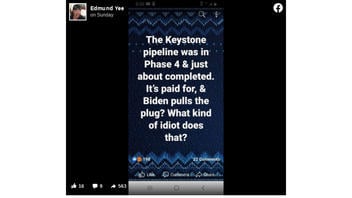
Was the "Keystone" pipeline "just about completed" when President Joe Biden stopped it? No, that's not true: Less than one tenth of the Keystone XL segment of the Keystone system was complete when Biden revoked the permit for Keystone XL by executive order on January 20, 2021. The XL, which is the fourth phase of the Keystone system, had not been funded by late 2020. The builder disclosed $6.9 billion - about 86% - of the needed $8 billion was to be raised in 2021 and 2022.
The claim appeared in a Facebook post (archived here) published on March 7, 2021. The post read:
The Keystone pipeline was in Phase 4 & just about completed. It's paid for, & Biden pulls the plug? What kind of idiot does that?
This is what the post looked like on Facebook at the time of writing:
(Source: Facebook screenshot taken on Tue Mar 9 18:00:40 2021 UTC)
The post fails to distinguish between the Keystone XL pipeline and the entire Keystone Pipeline System. The XL is the fourth phase of the latter, an oil pipeline system in the United States and Canada owned by TC Energy Corporation.
The Keystone Pipeline System stretches 2,687 miles, while Keystone XL was to be 1,210 miles in length. Keystone XL was designed to transport crude oil from Alberta, Canada, to Steele City, Nebraska, where it would connect with TC Energy's existing facilities, which extend to the Gulf Coast.
Almost from the start, Keystone XL faced opposition and delays. It became something of a political hot potato. The project was rejected under the administration of Barack Obama and revived by former President Donald Trump. On his first day in office, Biden issued an executive order that rescinded the construction permit for the Keystone XL pipeline, effectively stopping it.
When he did so, Keystone XL was far from complete. According to the Canada Energy Regulator, which regulates the Canadian portion of the Keystone XL Pipeline, some 93 miles (150 kilometers) of pipe had been installed by the end of 2020. That represents less than 30% of the Canadian portion of the pipeline, which was expected to be roughly 329 miles (530 kilometers) in length. An additional 1.4-mile (2.2-km) border crossing was completed in May 2020, encompassing the only section of the pipeline so far constructed in the U.S. In July, a U.S. Supreme Court decision further delayed the Keystone XL project. Taken together, those 94.4 miles are 8% of the 1,210 planned miles, meaning it was nowhere near complete when Biden took action against it.
It was also not entirely "paid for," as the post claimed.
In March 2020, TC Energy released a statement saying that the Keystone XL project would cost approximately $8 billion. Of that, the government of Alberta had agreed to invest some $1.1 billion, which "substantially covers planned construction costs through the end of 2020," according to the company, which added:
The remaining capital investment of approximately US$6.9 billion is expected to be largely made in 2021 and 2022 and funded through the combination of a US$4.2 billion project level credit facility to be fully guaranteed by the Government of Alberta and a US$2.7 billion investment by TC Energy.
Lead Stories reached out to TC Energy to ask where the funding stood, as well as general questions about the Keystone XL pipeline. We will update this story, as necessary, if we receive a response. From its 2020 statement, however, it appears the majority of the investment was expected to be made in 2021 and 2022. The Keystone XL pipeline had been scheduled to begin operating in 2023.
In the wake of Biden's order, TC Energy released a statement saying that the project would be suspended. Regarding costs, the company said:
The company will cease capitalizing costs, including interest during construction, effective January 20, 2021, being the date of the decision, and will evaluate the carrying value of its investment in the pipeline, net of project recoveries. Absent intervening actions, these steps could result in a substantative, predominantly non-cash after-tax charge to earnings in first quarter 2021. TC Energy will also modify its previously announced financing plans as it would no longer expect to issue hybrid securities or common shares under its dividend reinvestment plan to partially fund the project.
Lead Stories has covered previous claims about the Keystone XL pipeline and has collected them here.















